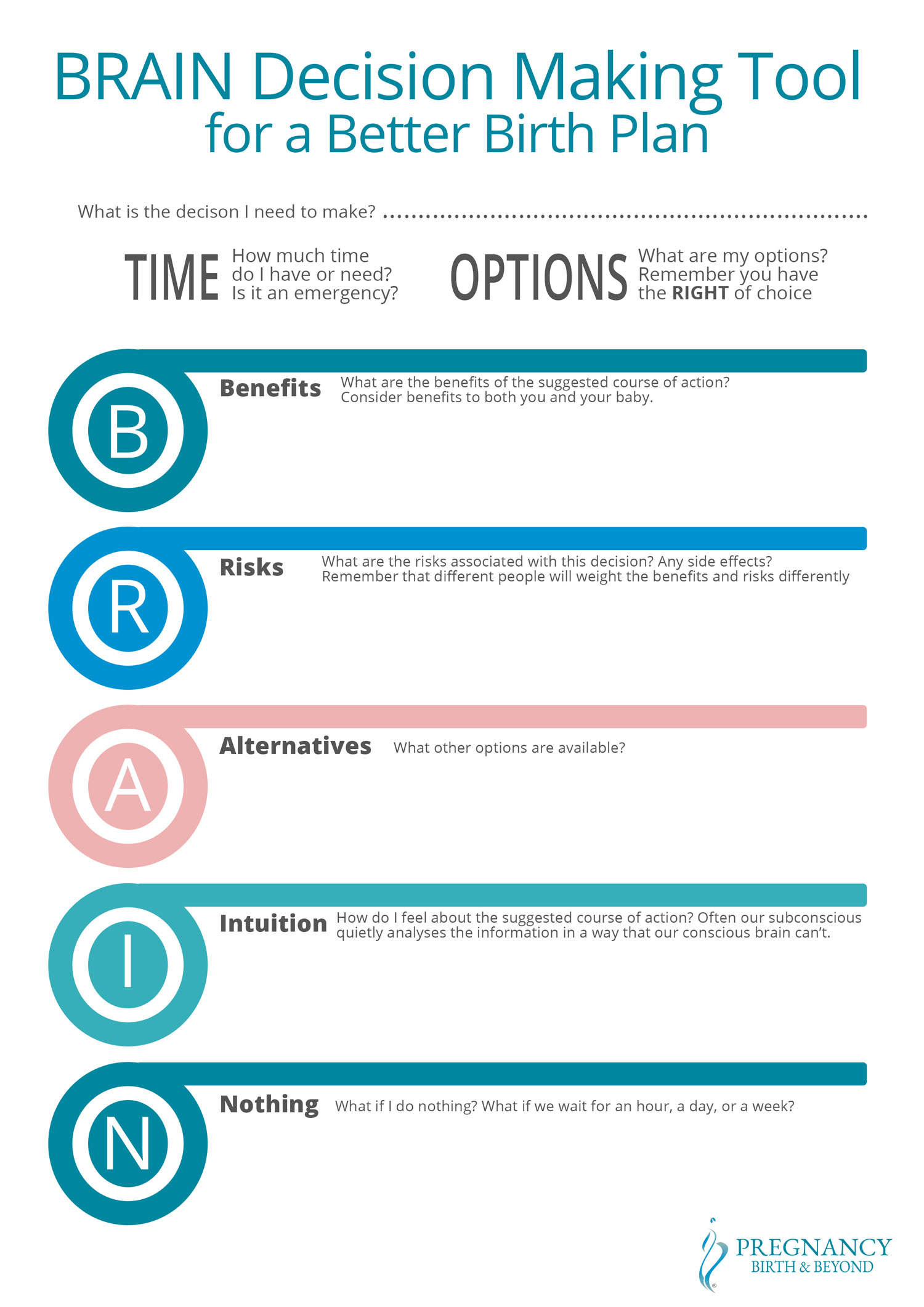 Using the BRAIN decision making tool can help you navigate pregnancy and birth decisions. Which tests and procedures do you want? What should your birth plan look like? These are opportunities to make proactive choices for yourself and baby.
Using the BRAIN decision making tool can help you navigate pregnancy and birth decisions. Which tests and procedures do you want? What should your birth plan look like? These are opportunities to make proactive choices for yourself and baby.
Sometimes a course of action is presented as a given, but you still have a choice. RANZCOG is the college that trains and accredits obstetricians. Most importantly they state that women have the right to make informed choices in pregnancy and birth.
What does informed choice mean? RANZCOG explains the importance of giving women detailed information relevant to their circumstances. Furthermore, it’s women’s right to receive information that could affect the pregnancy care and birth choices they make. In other words, if increase an knowledge could change your decision, a health professional should ensure you are informed.
Are women making informed decisions?
Regardless of official standpoints, research has shown that women don’t always get to make informed decisions. For example, in a Queensland survey of over 7,000 women, only 1 in 3 women who experienced an induced onset of labour made an informed decision to have the procedure. Worse, of those who had a planned caesarean birth, only half made an informed choice. In comparison, in unplanned caesareans, only one-fifth of women made an informed choice. However it’s encouraging for the women having epidurals, the majority (69%) made an informed decision to have it.
What role can you play?
While doctors and midwives have the best intentions, unfortunately, they juggle the needs of many women at once. As a result, when they recommend a course of action, they may not spend enough time discussing the pros and cons. Most importantly it’s up to you to ask questions. Certainly then you can make an active choice rather than passively accepting what’s said.
Ideally, you’ll talk about this before the actual birth at the birth plan stage. Therefore it’s also wise to talk to your support people about your preferences and reasoning. Furthermore this information puts them in a better position to advocate for you. Keep in in mind that birth can be unpredictable.
What is the BRAIN decision making tool?
The BRAIN acronym helps you remember what questions to ask at antenatal appointments and to write your birth plan. To clarify here is an outline of the BRAIN decision making tool:
Benefits
What are the benefits of the suggested course of action? Consider benefits to both you and your baby.
Risks
Consider the risks associated with this decision? Any side effects? Remember that different people will weigh the advantages and disadvantages differently. Remember what’s important to you might not be to someone else.
Alternatives
Are there other options are available? (Use the BRAIN acronym to consider them.)
Intuition
How do I feel about the suggested course of action? Given our subconscious quietly analyses the information in a way that our conscious brain can’t. If nothing else, acknowledging your feelings makes them easier to process.
Nothing
Consider the implications if I do nothing? What if we wait for an hour, a day, or a week?
Next, you might need to ask for time to decide, even just 10 minutes alone.
Now let’s look at how you’d use the BRAIN decision making tool in practice, starting with a birth ball.

BRAIN Decision Making Tool in action – Should I use a birth Ball?
Benefits
- During pregnancy, sitting on this large, inflatable exercise ball or doing movements on it can help get bub into an ideal birthing position. In turn, this can reduce your chances of caesarean birth.
- In early labour, it can be more comfortable than a chair.
- While in labour and birth, you can lean on it when kneeling on the floor and let gravity bring baby down.
- Birthing balls can reduce labour pain (see this review of the evidence).
- After birth, the ball makes a bouncy seat for settling baby.
Risks
- You could roll off the ball.
Alternatives
- During pregnancy, you can do other exercises to better position baby.
- While in labour, you can find comfortable positions on the bed, the floor, a stool, or the bath.
- Other pain management options include massage, birthing pools, nitrous oxide gas, hypnobirthing techniques, TENS and epidural, among others.
Intuition
What does your gut say about using a birthing ball?
Nothing
If you decide not to use a birthing ball, it’s unlikely to affect your pregnancy or birth.
BRAIN Decision Making Tool in Action – Should I have induction of labour?

Benefits
- A usually reliable method of bringing on the labour when life or health is at ris
- The baby can be born at a time when specialist attention and facilities are available. For example, paediatrician for ‘at-risk’ babies.
- Social reasons: being able to organise the birth when help is available for other children or the partner can be present>
Risks
- Unless the cervix is ready to dilate, the progress will be slow. Consequently, it may lead to a caesarean birth for ‘failure to progress’.
- If immobilised in bed, a mother will be less able to find comfortable positions for labour. However, it should be possible to provide a mobile drip stand. Also, the attachment of the drip into the back of the hand is often inconvenient.
- Higher likelihood of an instrumental birth using a vacuum or forceps. As a result of increased use of epidura
- Increased risk of above-average blood loss
- Greater difficulty with labour pain and the increased likelihood of requesting morphine or epidural
- Overstimulation of the uterus, causing stress to you and baby
- Over-riding of the body’s natural production of oxytocin. This results in decreased sensitivity to naturally released oxytocin in response to the suckling of the baby at the breast. Furthermore, this can lead to difficulty establishing lactation in the first few days post-partum.
Alternatives
- Natural induction methods such as – nipple stimulation, consuming raspberry leaf and undergoing acupuncture
- Caesarean birth
- Increased monitoring of the baby and wait on spontaneous labour
Intuition
Check-in with your gut feelings.
Nothing
Full term is from 37 weeks to 42 weeks. Therefore over 42 weeks in pregnancy is called post-term. Around 92% of women will give birth by 41 weeks (including natural labour, induced labour and caesarean births). So depending on your situation you could do nothing and reassess in a few days. Or even in another week (in consultation with your midwife or doctor).
If labour starts at 42 weeks, the risk of stillbirth doubles from the risk at 40 weeks. However the rate is low, 4-7 out of 1,000 births, at 42 weeks. The book Inducing labour looks at the risks and benefits of induction in more detail.
When creating your birth plan or making other decisions, remember to ask the questions. And importantly use your BRAIN decision making tool to make a proactive choice.
Brain Decision Making Tool Handout
Download our BRAIN decision making tool for a better birth plan handout. Let us know what you think.
Reference List
At PBB we aim to keep you informed with the latest research-based information. Check out our reference list used in the creation of this article.
Published 21st March 2020

 Wish List
Wish List

Hi, am I able to post this onto my facebook Doula page for my clients?
Hi Julie – That is not a problem. Please provide a link back to this page.